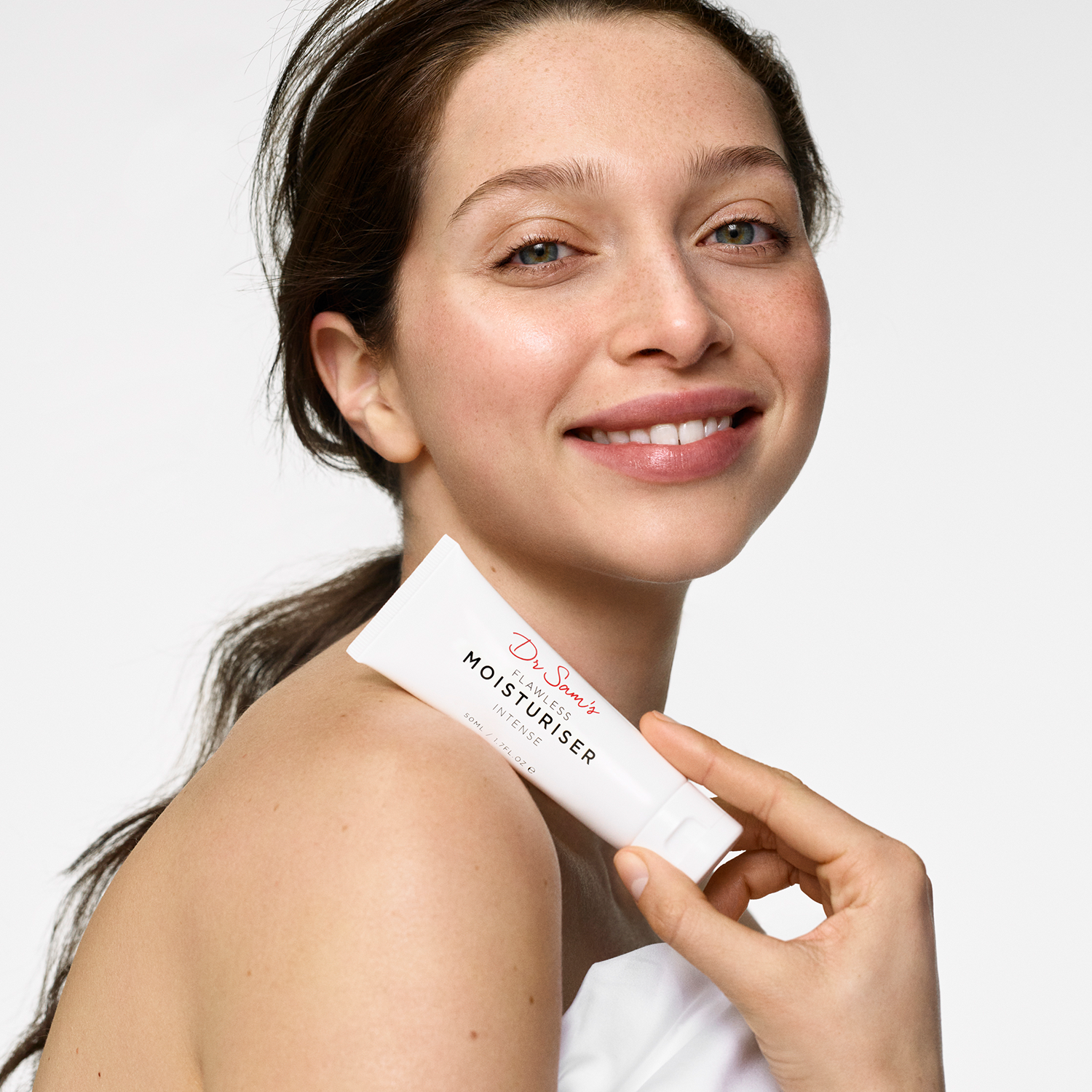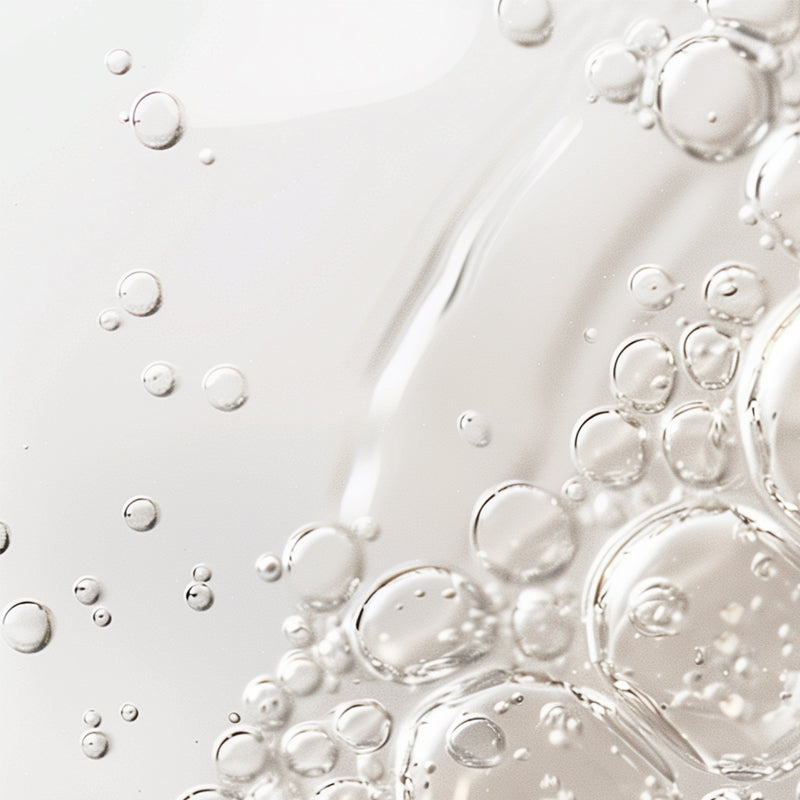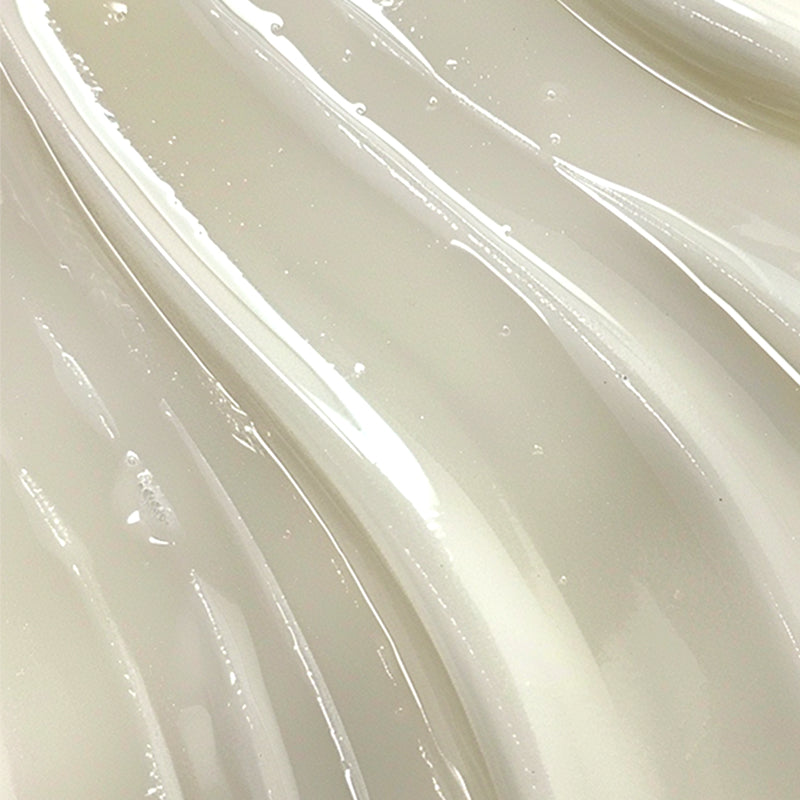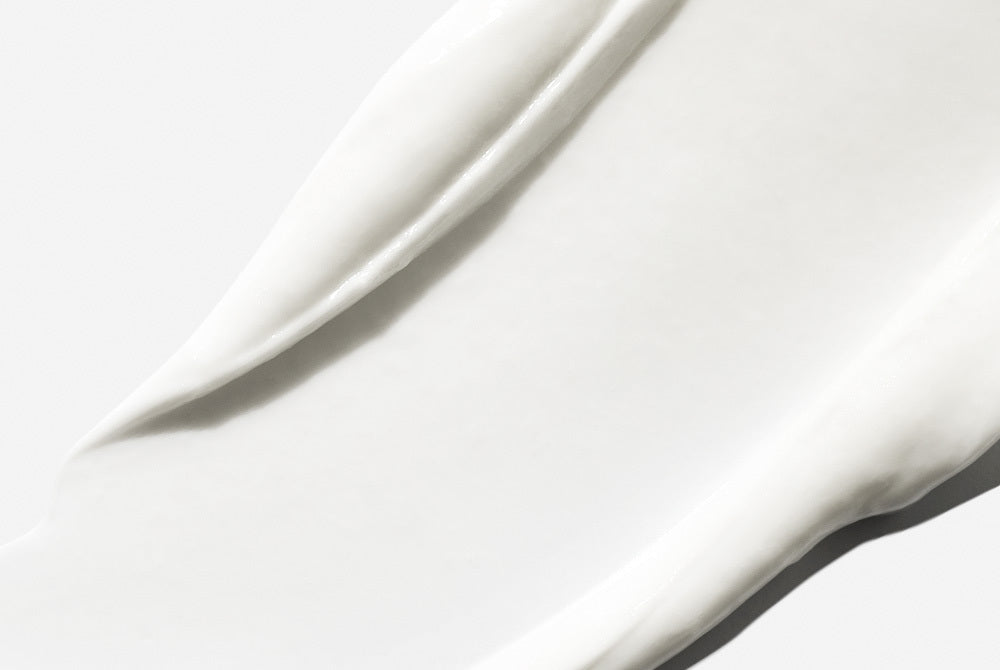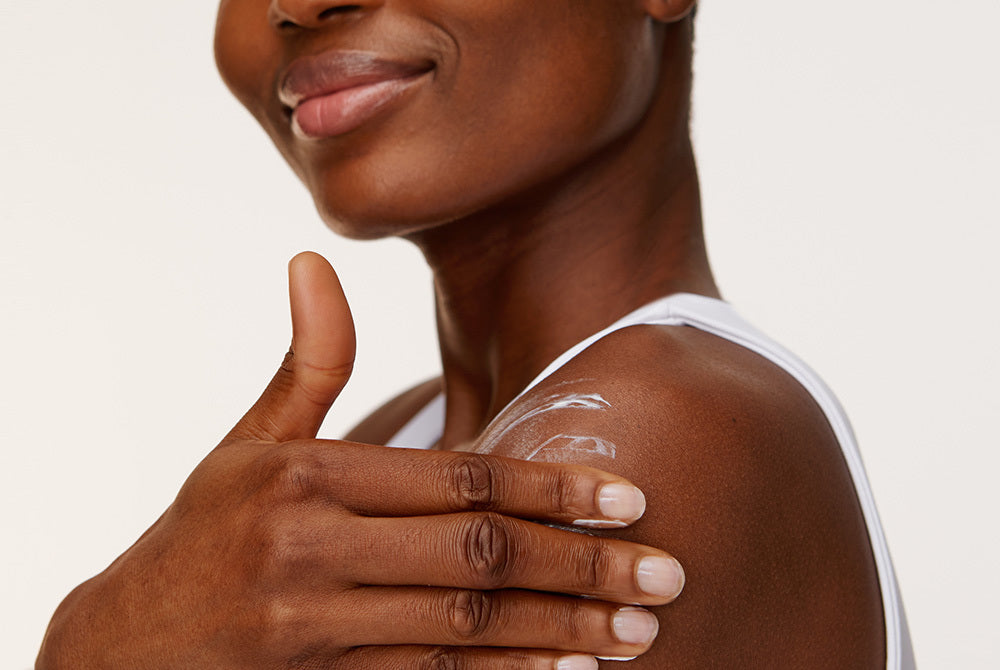Prenatal and postpartum skincare can feel confusing. Especially when you throw in a mix of hormones, body changes and new skin conditions in pregnancy you aren’t sure how to treat.
It’s unsettling not knowing for sure what you can and can’t use safely when going through so much change. So, let me share my straightforward approach to managing skin before, during and after pregnancy. Decoding pregnancy-safe ingredients, formulas and routines to support skin health during this time.
Read on for answers to all of your prenatal and postpartum skincare questions, from ‘can you use niacinamide when pregnant’ to the ‘best acne treatment while pregnant’. We’ll cover all bases.
Skin conditions in pregnancy
Let’s start with skin changes. There are several common skin conditions in pregnancy that many women experience. Here’s what they are, how they are caused, and how to manage them safely.
1. Hyperpigmentation
Pregnancy hormones can trigger changes in skin pigmentation. One of the most common skin conditions in pregnancy is melasma, affecting around 40% of pregnant women. It’s categorised by darker skin patches appearing around the lip, chin, nose and cheek areas. Freckles and moles may also become more prominent.
The number one rule to improve melasma and hyperpigmentation: stay out of the sun. When exposed to UV rays, affected areas of skin can get darker and more prominent. Safeguard skin with sunscreen daily like Flawless Gossamer Tint SPF 50, which has a subtle tint to help even out skin tone. To completely block out the sun, grab a big hat for shade. I like mine from Eric Javitts, Scala and Helen Kaminski, as they offer proper UV protection.
The three key ingredients that are going to help with melasma: vitamin C, niacinamide and azelaic acid. All are pregnancy-safe and can be used together, working synergistically to temper over-enthusiastic melanocytes (cells that produce melanin in skin and hair). More on how to use these in your routine later…
2. Breakouts
Stopping your regular acne medications can be daunting - but I do find that if acne is well-controlled before starting to try for a baby, switching to a pregnancy-safe regime is usually a smoother process than expected.
Be sure to plan this well ahead with your dermatologist, especially if you’re taking oral medications like spironolactone, isotretinoin or tetracyclines, which are all contra-indicated in pregnancy.
The good news is you do still have safe and effective options. So, if you’re experiencing this skin condition during pregnancy or postpartum, I find the combination of benzoyl peroxide and azelaic acid to be very effective at both treating and preventing acne. The addition of niacinamide is also calming and helpful in tackling post-blemish marks.
3. Stretch marks
One of the most common skin conditions in pregnancy, stretch marks are difficult. They basically represent torn elastin fibres in the dermis. The classic scenario is the continuous and progressive stretching of the skin over the abdomen during pregnancy (as many as 90% of pregnant women get them), but they also commonly develop during the growth spurt in puberty, on the shoulders of body builders and in those who are overweight. Ultimately, it’s the complex biochemistry of a woman’s body during pregnancy that is largely responsible for stretch marks.
Unfortunately, there is not a guaranteed solution for stretch marks to make them disappear completely, but there are ways to reduce them.
The only topical agent that there is any convincing evidence for is a topical retinoid - but this needs to be used for 3-6 months to make any impact. And of course, retinoids should not be used by pregnant women, so this is only recommended to try postpartum.
Lasers can be helpful in improving the red phase of stretch marks when they first appear (known as ‘striae rubrae’), but it's difficult to improve the appearance of the more advanced white silvery stretch marks. Collagen-stimulating treatments like medical needling and non-ablative fractional lasers may also help, but we need more research in this area. Again, these are recommended for postpartum, not during pregnancy.
My advice to support this skin condition during pregnancy: moisturise skin well, make sure you’re getting plenty of vitamin C in your diet and leave it at that.
4. Itchy, sensitive skin
If you often experience sensitive skin, taking a proactive approach is the smart move before pregnancy. Switch to a gentle, non-foaming oil or cream body wash to help prevent the drying effects of bathing and showering. Keep water warm, not hot, and avoid overly long baths - the hot water can strip moisture from skin and cause irritation. I also recommend simple, fragrance-free, soothing moisturisers to lock in hydration. Apply when skin is damp and be generous.
Certain rashes can also be associated with pregnancy, which can trigger a flare-up of common inflammatory conditions like eczema and psoriasis. So, if your skin starts behaving oddly, have a low threshold for seeing your doctor to discuss safe treatment options. Similarly, if you’re concerned about changes in your moles, seek advice to be on the safe side.
What to avoid in pregnancy and postpartum skincare
The important skincare ingredients I advise my patients to stop include retinoids, and hydroquinone.
The key thing is to plan this and wean skin onto a safe alternative to avoid anxiety around conception - I suggest doing this as soon as you start trying to get pregnant. I also recommend skipping soy in skincare, as this might theoretically increase the risk of melasma.
Finally, I recommend skipping cosmetic treatments, like Botox and fillers, in pregnant women.
Pregnancy and postpartum skincare routine
I know you have less time. So here’s my quick, easy routine to get breakouts under control and bring back your natural glow using gentle, effective formulas. Safe for use during pregnancy and while breast-feeding.
1. Gentle cleanser
This is much kinder to skin which is undergoing the influences of major hormonal changes, reducing the negative impact of cleansing on barrier function. Flawless Cleanser is fragrance-free and deeply cleans without stripping moisture or the skin barrier.
2. Pregnancy-safe acid
Azelaic acid is completely safe to use during pregnancy and whilst breast-feeding. It’s also much gentler than physical exfoliants, which can cause redness and irritation in pre- and post-pregnancy skin. Try Flawless Brightly 10% Azelaic Acid Serum to support skin health during this time. It’s formulated with 10% azelaic acid, which has multiple benefits including reducing redness and calming blemishes. Plus, vitamin C is on hand to brighten skin tone.
3. Hydrate skin
Loss of sleep often leads to increased skin dryness and tightness, so change up your moisturiser to compensate for this. Exchange your usual lightweight lotion for a more nourishing cream. Flawless Moisturiser is rich in ingredients like shea butter and squalane, which help reduce moisture loss from the surface of the skin.
4. Don’t forget SPF
As I’ve said, pregnancy can trigger melasma. Seek out a mineral filter-based sunscreen (look for zinc oxide at a minimum of 5%) to help reduce the provocation of pigment-inducing UVA rays. These rays are present all year-round, and can even pass through glass. Continue right through the post-partum period and beyond. Your daily non-negotiable for skin health.
Skincare ingredients in pregnancy
The ingredients that have the green light for use during pregnancy, and those that should only be used postpartum.
Can you use niacinamide when pregnant?
Yes, niacinamide is considered safe to use during pregnancy and postpartum. As an anti-inflammatory, it can help keep skin calm, reducing breakouts and supporting a strong skin barrier.
Can you use azelaic acid in pregnancy?
Yes, azelaic acid is also considered pregnancy-safe. This all-rounder ingredient can support skin conditions in pregnancy like melasma, breakouts and redness.
Can you use vitamin C in pregnancy?
Yes, this is one of the most glow-getting ingredients and works very well if you’re also tackling pigmentation. Consider Flawless Brightly Serum as your time and skin saver. It’s powered by four pregnancy-safe actives in one radiance-boosting formula: azelaic acid, vitamin C, bakuchiol and niacinamide.
Can you use AHAs while pregnant?
Yes. If skin is looking a little dull or lacklustre (like most of us when we’re getting less sleep than usual), try an alpha hydroxy acid (AHA) for radiance. An acid exfoliant that gently lifts away dead skin cells to reveal new ones below, for a brighter, fresher appearance. It’s safe to use during pregnancy and lactation.
Can you use retinoids in pregnancy?
Retinoids are not safe to use during pregnancy, so make sure you check the ingredient lists on your skincare products to make sure you aren’t applying this active.
Postpartum, it’s safe to start reintroducing retinoids again. This is the most common question we get around Flawless Nightly Serum, and indeed it’s a common worry with retinoids as a whole. Don’t fret, they’re fine. Just avoid breastfeeding immediately after application to avoid cream transferring onto your infant’s skin and irritating it.
Best acne treatment while pregnant?
Benzoyl peroxide is fine to use during pregnancy for breakouts. It’s one of the most effective spot treatments around, but it can be irritating. If your skin doesn’t like BPO, then try salicylic acid as an alternative (postpartum only - not to be used during pregnancy). Both are great for inflamed spots.
Want to learn more about all-rounder ingredient azelaic acid? Read azelaic acid 101: how to use it & what are the benefits? to become a pro.

